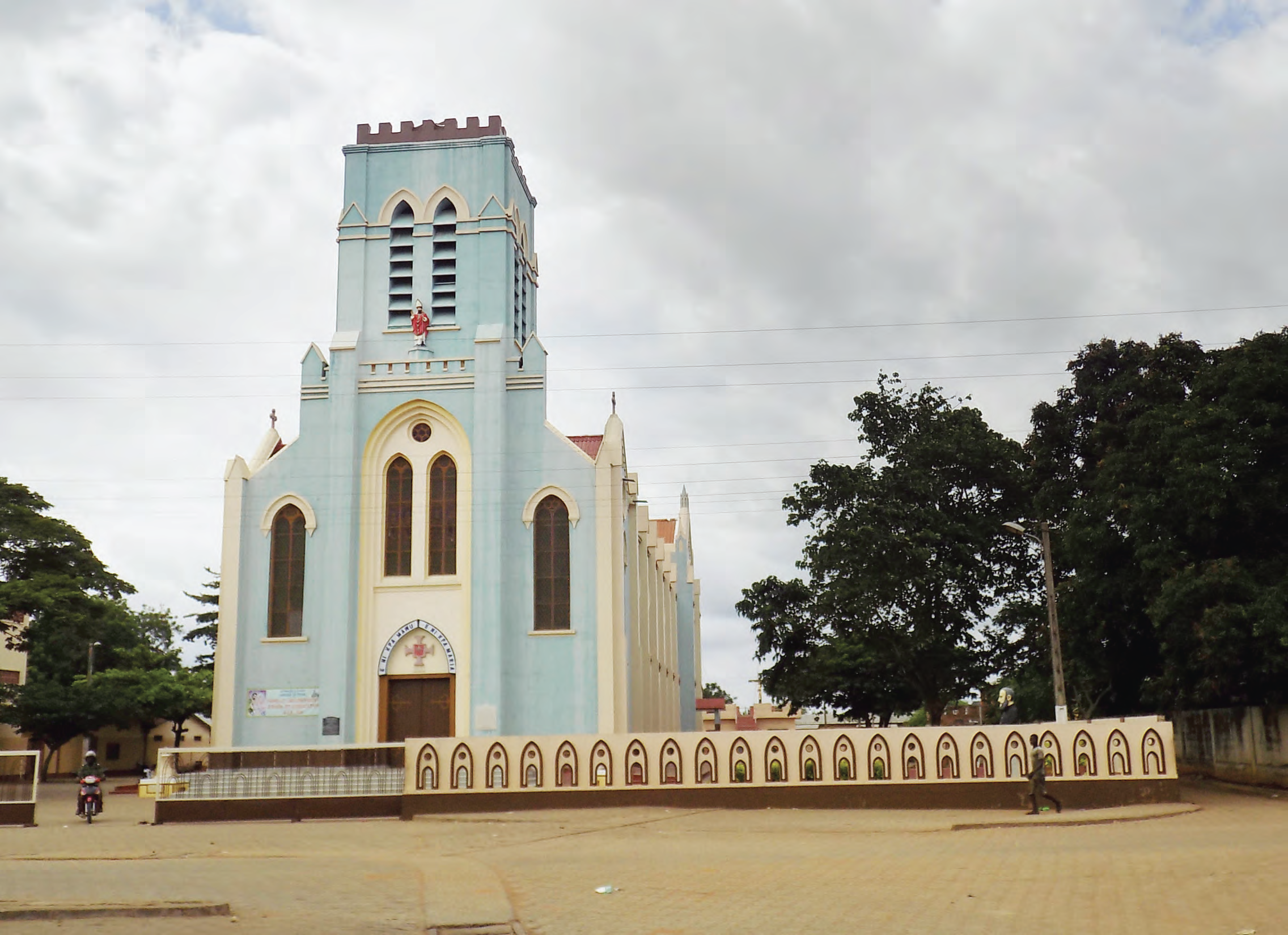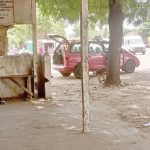Ouidah is also called the kingdom of Whydah; while the French refered to it as Juida, and the Portuguese called it Ajudá.
The distance between Ouidah and Cotonou, the largest city and economic centre of Benin Republic, is easily covered on a motorbike. On this short distance, however attractions abound as you will see artworks displayed by the roadside, sculptors and wood carvers also work by the roadside on various objects at different levels of completion.
Porto Novo was my initial destination from Cotonou, but the locals who I met on the Fidjrosse beach convinced me to head to Ouidah instead because “it is the land of snakes.“You will see plenty snakes, statues and slaves,” one told me, which I later found to be true except the slaves’ part.
Another, mixing French and English,tried to explain to me that all tourists visiting the Republic of Benin go to Ouidah. To buttress his point, he told me that it was a UNESCO World Heritage site. That was not entirely true as the historic site is only on the tentative list.
The road that leads to Ouidah from Cotonou also takes you to Togo and beyond. Half way there, is a collector’s museum called “Musee International Avimadjessi.”

From the outside, the building doesn’t show much promise but inside was a different ball game, as the museum happened to be about artifacts from different parts of the world. It was basically an art collector’s hobby turned into a museum.
The founder and curator, Mr. Denis Avimadjessi, who aside from French, relatively communicates in English and a little of Hausa and Yoruba languages, said he has been collecting for over 30 years. He explained that he started and got interested while working in diplomatic missions in different countries.
He collects a wide range of objects and items from different places he had worked or visited. For instance, if a shelf in the museum is titled water god, it will have different water gods from different countries. Same applied to money, bottles and masks. There was also collection of classic books, classic movies in VHS, newspapers that have gone out of print and first editions of some newspapers and so on.
On getting to Ouidah you are greeted by this magnificent gate post that can rival the “welcome to Abuja” city gate if you are approaching from the airport. In the historic city of Ouidah, there are several historical sites that attract tourists in their droves to the extent that, according to one of the museum guide, they have an almost 24/7 ‘government’ tourist office where you can hire tourist guide for a fee.
I didn’t use the government tourist guide because it was above budget. Secondly, I was informed they had none that could communicate in English, Hausa, Igbo, or Yoruba – except in French and Portuguese – in addition, I came with a driver, Abdul, who happened to know the town and speaks English.
My first point of call was “MuseeD’Histoire De Ouidah” (Ouidah museum of history). It is an understandable error for tourists to make the mistake of thinking that MuseeD’Histoire De Ouidah and Forte De S. Joao Baptista de Ajuda (Fort of St. John the Baptist of Ouidah) are two different sites.
I also made the mistake, but later found out that the Ouidah museum is located within the compound of Fort of St. John the Baptist of Ouidah. In fact, it is some of the rooms of the master’s house that are used as the museum.

The Fort of St. John is a small fortress built by the Portuguese to protect their slave business interest. It was basically a house of one of the Portuguese slave trading lords. It contained the master house, a church which was founded in 1856 by the “Societe des missions Africaines” and a block of rooms which served as the soldiers barracks. Behind the soldiers barracks are a row of tiny cubicles where slaves, shackled in chains, were kept before they were transported to the sea ports for shipping overseas.
The museum guide said back then, the slaves were fed once a day. Behind the masters house separated by a low fenced house is what appeared to have served as a garden for the slave traders.
The four corners of the outer fence are fitted with an outpost where soldiers stayed to be on the lookout.
At the left hand side of the master’s house, were a couple of cannons for display. I was made to understand by the soft spoken young museum guide, who told me that he was a student, that during the slavery era a cannon was sold for 25 female slaves or 15 male slaves or for a chief.

Avimadjessi”
Inside the rooms that serve as museum, which was more pictorial and textual with ancient and modern photos depicting the people of Ouidah then and now, maps, architectural models of various forts and some relics, would have been more appreciated by those who understand the language.
The fort had an impact in Benin because of its contribution to the Portuguese and African slave trade. The Portuguese language was the only foreign language that the then Kings of Dahomey authorised, explained the official guide.
The abolition of the slave trade made the fort, which had before been one of the major slave ports, gradually lose its importance.
My next stop was the “La Porte du non retour” which translates to “The door of no return”. It was a bit off town and quite a journey on an untarred, lonely road with little vehicular or people traffic.
The ‘Door of no Return’ is actually a gate-like monument marking the port area where slave ships docked and slave traders stayed and conducted business. It was called the ‘door of no return’ by the locals because back then it was the last place slaves marched through to the boats which will take them to the slave ships destined for other continents from where they were never seen again.
At both sides of the gate is an abstract metal work of forms depicting slaves shackled together with chains, waiting to be loaded onto the slavers’ ships.
For the duration of the journey back and forth, we passed two vehicles, a pickup truck and a couple of motorcycles. Both side of the road which is also called the slave route was decorated at regular intervals with animate and inanimate life size statues that ranged from human, lion, bird, chameleon until you get the ‘Door of no Return’ which overlooks the sea.
Aside the statues, there are a spattering of small picturesque fishing villages along the road. On the right hand side of the monument are several houses said to have served the people who were into the slave trade business then.
There is a recent addition of a voodoo temple standing guard on the grounds of the ‘Door of No Return’.
Just before the ‘door is the “Tree of Forgetfulness” or a statue at the spot where the tree existed. It was said that slaves circled the tree a number of times so that they can forget their identity when they embark on the slave ship.
There is supposed to be a “Tree of Memory” or remembrance which I couldn’t locate. (Those who returned are expected to circle it so that they can recall their identity and find their way back home). And “Zomai” a building built like a ship hulk where the slaves are kept for months with no light so that they can get accustomed to the ship before the journey begins. Those who don’t survive it are buried in a mass grave.
A little distance from the ‘Door of No Return’ was a raised plaque-like fence with an enormous map of Benin cut in the middle, along with a granite cross which can be seen from both sides of the wall because of the map.
The monument “Memorial du grand jubile de L’an 2000” is a memorial to commemorate the arrival of missionaries in Benin. On the wall there are biblical verses, missionaries names and pictures of people.
A couple of meters away along the beach is a smaller monument depicting the ‘Door of Return’. This serves as a memorial for those who came back. It has three bronze statues with the larger statue representing a mother welcoming her children, a man and a woman in western attire holding a valise back home.
From there, I went to the “Temple des Python” that is “Voodoo Temple of Snakes” which interestingly was directly opposite a church called the Basilica of the Immaculate Conception.
What struck me was the stark reality of why the African religion is dwindling and dying fast, the church stood tall, clean and elegant while the voodoo temple which was said to have been in existence years before the church, looked desolate and dejected and dirty.

Just by the entrance of the Voodoo Temple of Snakes is a sculpture of a woman holding a snake. She is honoured as the mother of the temple because she is credited with bringing snakes to Ouidah.
The temple priests, clad in white attire seat at the gate.
There are two categories of access fee charges; if you want to tour the temple without taking photos and if you want to take photos.
One of the temple priests who understands Yoruba language while responding to my question on how the church and the voodoo temple exist side by side, said the town is religion, adding that even though Voodoo is the oldest religion, it is not uncommon to see a person partaking in activities across the different religions. He explained that there is a mosque a few metres away.
Inside the temple there is a clay water pot buried halfway upside down, rituals and incantations are done over it. The pot, according to the priest, is opened once after several years.
There are several huts, with the biggest housing quite a large number of snakes of different sizes and shapes. The middle of the hut has a large hole which looks like a well with steps.
The snakes are fed eggs and what looked like palm oil. At certain times the priest said the snakes are allowed to go out and that they come back. There is also an enclosure that looked like a recreation of a forest. The lead priest said there are more snakes there but that it was forbidden for females to go there.
All photos by Bamas Victoria

 Join Daily Trust WhatsApp Community For Quick Access To News and Happenings Around You.
Join Daily Trust WhatsApp Community For Quick Access To News and Happenings Around You.


